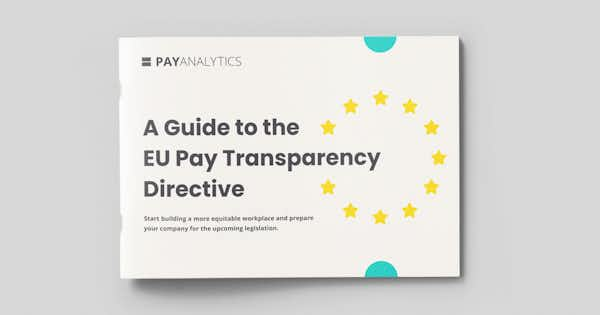Vorbereitung auf die EU-Lohntransparenzrichtlinie | Laden Sie unser E-Book kostenlos herunter
Messen

Individuelle Lohngleichheit
Lohngleichheit hilft, Gehaltsstrukturen zu klären, indem sie die Treiber der Vergütung identifiziert, was informierte Entscheidungen und sicheres Vorankommen ermöglicht.
Überblick über alle Produktfunktionen
Erreichen Sie Ihre Ziele zur Lohngleichheit mit der PayAnalytics-Software. Sie ist darauf ausgelegt, Sie mit minimalem Setup schnell startklar zu machen – unterstützt durch Videotutorials und leicht verständliche Dokumentation.
Analyse der Lohngleichheit
Legen Sie die Faktoren offen, die das Gehalt beeinflussen, und treffen Sie informierte Entscheidungen.
Wertbasierter Vergleich
Vergleichen Sie verschiedene Jobs unter dem Prinzip „gleicher Lohn für gleichwertige Arbeit“.
Personalanalyse
Untersuchen und fördern Sie Vielfalt, leiten Sie DEI-Maßnahmen effektiv innerhalb Ihrer Organisation.
Abhilfemaßnahmen
Erhalten Sie maßgeschneiderte Empfehlungen, um Gehaltslücken zu schließen, angepasst an Ihre Bedürfnisse und Ihr Budget.
Berichte
Wesentliche Werkzeuge für globale Compliance und anpassbare Berichte für die Führungsebene.
Vergütungsassistent
Unterstützen Sie einen vorurteilsfreien Arbeitsplatz, indem Sie für gute Vergütungsentscheidungen sorgen.
Datenmanagement
Verfeinern Sie importierte Daten in PayAnalytics einfach durch Korrekturen, Bearbeitungen und Ergänzungen, um Genauigkeit und Sichtbarkeit zu gewährleisten.
Stellenbewertung
Erstellen Sie objektive Vergütungsstrukturen, vergleichen Sie verschiedene Rollen basierend auf dem organisatorischen Wert.
Benutzerzugriffskontrollen
Feingranulare Zugriffskontrollen, da Benutzer unterschiedliche Bedürfnisse bezüglich des Datenzugriffs haben.

Sind Sie bereit für die EU-Richtlinie? Wir haben ein E-Book zusammengestellt, um Ihnen zu helfen, die neuen Anforderungen zu verstehen.
Ressourcenübersicht
Wir haben ein Wissenszentrum zusammengestellt, um Ihnen zu helfen, sich in allem rund um Gehaltsgerechtigkeit, DEI (Diversity, Equity, Inclusion) und Workforce Analytics zurechtzufinden. Dies umfasst Artikel, herunterladbare E-Books, Podcasts und mehr.
Anleitungen und E-Books
Entdecken Sie unsere praktischen Anleitungen, die Ihnen praktische Ratschläge zur Erreichung von Gleichberechtigung am Arbeitsplatz geben. Sie sind in Form von Artikeln und herunterladbaren E-Books verfügbar.
Artikel und Blogs
Bleiben Sie informiert über Gehaltsgerechtigkeit, Transparenz, Fairness am Arbeitsplatz, Kommunikationsstrategien und aktuelle Trends.
Lokale Anforderungen
Bleiben Sie auf dem Laufenden über die sich ändernde Rechtslandschaft und entdecken Sie, welche Vorschriften für Sie gelten könnten.
The Coffee Talk Podcast
Die neuesten Nachrichten über Gehaltsgerechtigkeit in nur 8 Minuten — jeden zweiten Freitag mit Margrét & Henrike.
Kundenerfolgsgeschichten
Lesen Sie, wie Unternehmen mit PayAnalytics die Gehaltslücke geschlossen haben.

PayAnalytics von beqom übernommen
PayAnalytics gab seine Übernahme durch beqom bekannt, einen führenden Anbieter von Gesamtlösungen für Vergütung und Leistungsmanagement.
Über uns
Wir glauben, dass Gehalt mehr als nur eine Zahl ist. Unsere Software basiert auf über einem Jahrzehnt Forschung und Entwicklung durch preisgekrönte Professoren, Experten für Gehaltsgerechtigkeit und Ingenieure.
Karriere
Treten Sie unserem leidenschaftlichen und hochqualifizierten Team bei. Wir sind Pioniere auf unserem Gebiet und unterstützen Unternehmen dabei, faire Arbeitsplätze zu schaffen.
Nachrichten
Die neuesten Unternehmensupdates, wie Veranstaltungen, Neuigkeiten von Kunden, Pressemitteilungen und vieles mehr.
Marke
Erhalten Sie einen Überblick über unsere Marke, Auszeichnungen und Geschichte. Hier finden Sie herunterladbare Markenressourcen und Fotos.
Partnerschaften
Wir arbeiten mit verschiedenen Partnern zusammen, um Transparenz und Fairness in der Gehaltspraxis zu fördern. Entdecken Sie Partnerschaftsmöglichkeiten.
Beratungsleistungen
Maßgeschneiderte Beratungsleistungen zur Umsetzung von Lohngerechtigkeit, entwickelt, um den Einsatz unserer Software zu ergänzen und zu optimieren.
Überblick über alle Produktfunktionen
Erreichen Sie Ihre Ziele zur Lohngleichheit mit der PayAnalytics-Software. Sie ist darauf ausgelegt, Sie mit minimalem Setup schnell startklar zu machen – unterstützt durch Videotutorials und leicht verständliche Dokumentation.
Analyse der Lohngleichheit
Legen Sie die Faktoren offen, die das Gehalt beeinflussen, und treffen Sie informierte Entscheidungen.
Wertbasierter Vergleich
Vergleichen Sie verschiedene Jobs unter dem Prinzip „gleicher Lohn für gleichwertige Arbeit“.
Personalanalyse
Untersuchen und fördern Sie Vielfalt, leiten Sie DEI-Maßnahmen effektiv innerhalb Ihrer Organisation.
Abhilfemaßnahmen
Erhalten Sie maßgeschneiderte Empfehlungen, um Gehaltslücken zu schließen, angepasst an Ihre Bedürfnisse und Ihr Budget.
Berichte
Wesentliche Werkzeuge für globale Compliance und anpassbare Berichte für die Führungsebene.
Vergütungsassistent
Unterstützen Sie einen vorurteilsfreien Arbeitsplatz, indem Sie für gute Vergütungsentscheidungen sorgen.
Datenmanagement
Verfeinern Sie importierte Daten in PayAnalytics einfach durch Korrekturen, Bearbeitungen und Ergänzungen, um Genauigkeit und Sichtbarkeit zu gewährleisten.
Stellenbewertung
Erstellen Sie objektive Vergütungsstrukturen, vergleichen Sie verschiedene Rollen basierend auf dem organisatorischen Wert.
Benutzerzugriffskontrollen
Feingranulare Zugriffskontrollen, da Benutzer unterschiedliche Bedürfnisse bezüglich des Datenzugriffs haben.
Ressourcenübersicht
Wir haben ein Wissenszentrum zusammengestellt, um Ihnen zu helfen, sich in allem rund um Gehaltsgerechtigkeit, DEI (Diversity, Equity, Inclusion) und Workforce Analytics zurechtzufinden. Dies umfasst Artikel, herunterladbare E-Books, Podcasts und mehr.
Anleitungen und E-Books
Entdecken Sie unsere praktischen Anleitungen, die Ihnen praktische Ratschläge zur Erreichung von Gleichberechtigung am Arbeitsplatz geben. Sie sind in Form von Artikeln und herunterladbaren E-Books verfügbar.
Artikel und Blogs
Bleiben Sie informiert über Gehaltsgerechtigkeit, Transparenz, Fairness am Arbeitsplatz, Kommunikationsstrategien und aktuelle Trends.
Lokale Anforderungen
Bleiben Sie auf dem Laufenden über die sich ändernde Rechtslandschaft und entdecken Sie, welche Vorschriften für Sie gelten könnten.
The Coffee Talk Podcast
Die neuesten Nachrichten über Gehaltsgerechtigkeit in nur 8 Minuten — jeden zweiten Freitag mit Margrét & Henrike.
Kundenerfolgsgeschichten
Lesen Sie, wie Unternehmen mit PayAnalytics die Gehaltslücke geschlossen haben.
Über uns
Wir glauben, dass Gehalt mehr als nur eine Zahl ist. Unsere Software basiert auf über einem Jahrzehnt Forschung und Entwicklung durch preisgekrönte Professoren, Experten für Gehaltsgerechtigkeit und Ingenieure.
Karriere
Treten Sie unserem leidenschaftlichen und hochqualifizierten Team bei. Wir sind Pioniere auf unserem Gebiet und unterstützen Unternehmen dabei, faire Arbeitsplätze zu schaffen.
Nachrichten
Die neuesten Unternehmensupdates, wie Veranstaltungen, Neuigkeiten von Kunden, Pressemitteilungen und vieles mehr.
Marke
Erhalten Sie einen Überblick über unsere Marke, Auszeichnungen und Geschichte. Hier finden Sie herunterladbare Markenressourcen und Fotos.
Partnerschaften
Wir arbeiten mit verschiedenen Partnern zusammen, um Transparenz und Fairness in der Gehaltspraxis zu fördern. Entdecken Sie Partnerschaftsmöglichkeiten.
Beratungsleistungen
Maßgeschneiderte Beratungsleistungen zur Umsetzung von Lohngerechtigkeit, entwickelt, um den Einsatz unserer Software zu ergänzen und zu optimieren.

- Startseite
- Ressourcen
- Artikel
Artikel und Blogs
Hier finden Sie eine umfassende Sammlung von Artikeln, die sich der Förderung von Chancengleichheit am Arbeitsplatz, Lohntransparenz und Praktiken in Bezug auf Diversität, Gleichheit und Inklusion (DEI) widmen. Von praktischen Ratschlägen zum Navigieren durch Lohngleichheitsgesetze in verschiedenen Ländern bis zu tiefgreifenden Analysen von Berechnungen der Geschlechterlohnlücke und den Vorteilen fairer Lohnpraktiken für die Anziehung und Bindung von Talenten, unsere Ressourcen sind darauf ausgerichtet, Organisationen und Einzelpersonen zu unterstützen, die sich für bedeutende Fortschritte hin zur Gleichheit am Arbeitsplatz einsetzen. Nicht alle Artikel sind aus dem Englischen übersetzt.
- Artikel
Over the last several years, Portugal has strengthened its pay equity laws. They emphasize transparency, and employers with gender pay gaps may be asked to create a pay equity evaluation plan. This short article provides information to help employers in Portugal be prepared and proactive.
- Artikel
Japan has the largest gender pay gap of any G7 nation. To promote workplace equality, keep women in the labor force after childbirth, and increase advancement opportunities, the country recently made changes to its pay gap reporting requirements.
- Artikel
PayAnalytics’ new Workplace Equity feature helps organizations move beyond equity in pay alone. This feature helps companies analyze diversity and representation among current employees, new hires, and employees who exit the organization, and it looks for demographic differences in who receives raises and promotions.
- Artikel
- Entgeltgleichheit
In 2023, Washington State expanded its pay transparency requirements by creating the Equal Pay and Opportunities Act (EPOA). Rather than disclosing a job’s minimum pay when making an applicant a job offer, the EPOA requires employers to disclose pay ranges in the job posting. In 2025, an amendment was passed to give employers a short window to correct noncompliant postings, to reduce statutory damages for noncompliance, and to clarify the wage information required in postings.
- Artikel
In summer 2022, Ireland implemented a far-reaching pay equity legislation, the Gender Pay Gap Information Act 2021. This legislation requires employers to begin reporting on their gender pay gaps. Companies will need to report differences in the mean and median pay between male and female employees. And if there’s a pay disparity, the company will need to provide a written explanation for it and outline any steps planned to close the gap.
- Artikel
As pay transparency laws continue to gain traction across the US, California employers are getting ready to comply with the state’s new pay reporting and pay disclosure law. It was signed by Governor Newsom on September 27, 2022.
- Artikel
PayAnalytics looks back on a productive 2022. We rolled out several new features to support customers on their pay equity journeys, and we celebrated big milestones for several of our customers. In addition, our team presented at conferences and published their research to promote pay equity worldwide.
- Artikel
Companies hiring in New York City have been changing the way they advertise job openings in response to the new pay transparency law. The New York City pay transparency law's effective date was November 1, 2022, and since then, companies with four or more employees must post the pay range for every job posting. The law covers all NYC-based companies. It also covers companies beyond city limits posting remote jobs that may be filled by NYC-based workers.
- Artikel
Demografische Lohnunterschiede stellen heute ein wachsendes Problem dar, und Unternehmen, Organisationen und Regierungen suchen nach Lösungen, um gleiche Bezahlung zu gewährleisten. Zwei Konzepte werden regelmäßig als „Lohngefälle" oder „Lohnlücke" bezeichnet Was ist der Unterschied zwischen bereinigtem und unbereinigtem Lohngefälle?
- Artikel
At PayAnalytics, we often talk about equal pay for work of equal value. Canada’s Pay Equity Act, implemented August 2021, takes a unique approach to achieving this objective. Typically, pay equity requirements focus on how men and women doing similar jobs are paid, but Canada now focuses on the value of the job to the employer.
- Artikel
Last week, our founders David Anderson and Margret Bjarnadottir presented their academic work at the WorldatWork Workplace Equity Forum 2022 in Austin, Texas.
- Artikel
"With the right tools, supported with the right data, we can bring about workplace transformation and pay equity."
In the latest issue of Dynamic Magazine, our founder Margrét shares valuable insights for leaders using data analytics or AI on their pay equity journeys.
PayAnalytics Newsletter erhalten
Unser Newsletter behandelt Themen wie Vergütung und Lohngleichheit, DEI (Diversity, Equity & Inclusion) sowie Gesetzesänderungen und Neuigkeiten zu unserem Unternehmen und Software-Updates.











